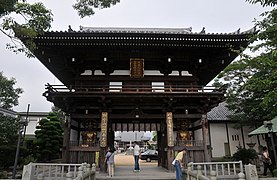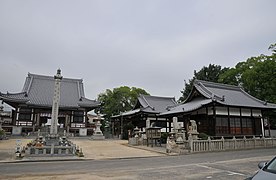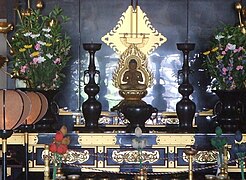Nankō-bō
The Nankō-bō ( Japanese 南 光 坊 ) with the Go Bekkusan (別 宮 山) and Kongōin (金剛 院) is a temple of the Omuro direction (御 室 派) of Shingon Buddhism in the city of Imabari (Ehime prefecture). In the traditional census it is the 55th temple on the Shikoku pilgrimage route , the only one that calls itself bō , meaning hermitage .
history
According to tradition, the temple was founded as a Buddhist place of prayer at the Ōyamazumi shrine ( 大 山 祇 神社 ) in Taihō 3 (703) by the "father of the navy" Ochi Tamasumi ( 越 智 玉 澄 ) with 24 Klausen on the island of Ōmi ( 大 三島 ). Since it was in an inconvenient place for the seafarers' prayers, it was moved to its present location in the city of Imabari. In the 1st year Wadō (708) Gyōki summarized 8 of the Klausen under the name ( 日本 総 鎮守 三島 の 御前 Nihon sōchinju Mishima no gozen ). Later, Priest Kūkai consolidated the position of the place of prayer.
During the fighting of the Tenshō period (1573–1592) the shrine and temple burned down, only the Nankōbō was rebuilt. In 1600 the temple became the place of prayer for Prince Tōdō Takatora , who built the hall for the healing Buddha, the Yakushidō ( 薬 師 堂 ). The subsequent princes, the Hisamatsu , further promoted the temple.
At the beginning of the Meiji period , the temple received the sculptures of the Daitsūchishō-Buddha ( 大通 智勝 如 来 ) with the accompanying Miroku Bosatsu ( 弥勒 mit ) and a Kannon for the Yakushidō as part of the separation of Buddhism and Shintoism . - At the end of the Pacific War , Imabari was bombed in August 1945, the temple largely burned down, but was gradually rebuilt after the war.
The attachment
You enter the temple from the northeast through the temple gate (山門, Sammon; 1), which is designed here as a tower gate (楼門, Rōmon). It was restored in autumn 1998 and houses the four kings of the sky in a modern, colored design to the right and left of the passage . Ahead at the end of the temple area is the main hall (本 堂, Hondō; 2), built in autumn 1981, immediately to the right is the Daishidō (大師 堂; 3). The Yakushi Hall (薬 師 堂; 4), which was replaced in the spring of 1991, and the preserved Kompira Hall (金 毘羅 堂; 5) stand next to the main hall on the edge of the temple grounds. Also to be mentioned are the holy Benzaiten (弁 財 天; 6) on a tiny island in the water around the entrance gate and the modern stone column on which a Gorintō (7) stands above .
The Imabari Munetada Shrine (今 治 宗 忠 神社; S) is located on the lower left of the map. The Bekku Ōyamazumi Shrine is on the right across the street.
photos
Remarks
- ↑ In front is the stone stupa, behind it the main hall, on the right in front the Kompira hall, behind it the Yakushi hall.
literature
- Ehime-ken kotogakko chireki komin bukai rekishi bukai (Ed.): Nankobo . In: Ehime-ken no rekishi sampo. Yamakawa Shuppan, 2008. ISBN 978-4-634-24638-6 . Page 100.
- Oguri, Doei: Kukai. Shikoku hachijuhachi kosho no arukikata. Chukei no Bunko, 2011, ISBN 978-4-8061-4067-2 .
Web links
Coordinates: 34 ° 4 ′ 7.5 ″ N , 132 ° 59 ′ 44.7 ″ E






